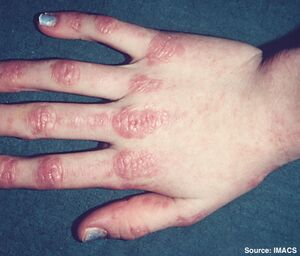Dermatomyositis
Original Editors Megan Sarason from Bellarmine University's Pathophysiology of Complex Patient Problems project.
Top Contributors - Megan Sarason, Admin, Lucinda hampton, Elaine Lonnemann, Kim Jackson, Khloud Shreif, 127.0.0.1, Wendy Walker and WikiSysop
Introduction[edit | edit source]
Dermatomyositis is an autoimmune inflammatory myositis, possibly related condition to polymyositis.[1] It is characterized by inflammatory and degenerative changes in the muscles and skin leading to symmetric weakness and some degree of muscle atrophy, principally in the limb girdles, neck and pharynx. This disease has also shown to effect the esophagus, lungs, and least commonly the heart. Also classified in the umbrella term Inflammatory Myopathies.[2][3][4]
Epidemilogy[edit | edit source]
Female predilection. Bimodal age pattern: Juvenile dermatomyositis (JDM), affects children and is more severe; Adult dermatomyositis (ADM) usually affects adults around the age of 50.[1]
Etiology[edit | edit source]
The cause of dermatomyositis is unknown, however several genetic, immunologic, and environmental factors are implicated in this condition.[5]
Characteristics/Clinical Presentation[edit | edit source]
Classically presents with a symmetrical proximal myopathy with associated dermatological changes including, dusky-red rash over the face, arms, hands, legs and other features. Other features include, dysphagia, myalgia, fever and weight loss[1]
Complications Malignancy[edit | edit source]
There is a sixfold increased risk of malignancy in dermatomyositis. This risk appears to be highest in patients diagnosed with dermatomyositis after 45 years of age. Risk factors include: >60 years old; male; dysphagia; necrosis of the skin; cutaneous vasculitis; accelerated onset of disease; increased creatine kinase (CK) levels; increased ESR and C-reactive protein (CRP) levels.[1]
Diagnostic Tests/Lab Tests/Lab Values[edit | edit source]
laboratory studies are helpful but nonspecific:
- ESR frequently elevated
- Antinuclear antibodies (ANA) elevated in 60 to 80 percent of patients
- Elevated creatine kinase (CK) enzyme, transaminases, and lactate dehyrogenase levels
- EMG to measure the electrical activity of the muscles: typically present as short-wave and fibrillations or myopathic pattern, 10 percent are false-negative
- Rheumatoid factor: elevated in 20 percent of patients, most often in those with overlap syndromes
- Neopterin and factor VIII–related antigen (von Willebrand factor): reported to correlate with juvenile DM[6][4]
Systemic Involvement[6][edit | edit source]
Systemic manifestations:
Common: proximal muscle weakness, dysphonia, dysphagia
Less common: respiratory muscle weakness, visual changes, abdominal pain
Systemic complications/association:
Cardiomyopathy
Cardiac conduction defects
Aspiration pneumonia secondary to respiratory muscle weakness
Diffuse interstitial pneumonitis/fibrosis
Large-bowel infarction secondary to vasculopathy has occurred in juvenile patients with myositis
Muscle atrophy
Muscle calcification
Ocular complications including iritis, nystagmus, cotton-wool spots, optic atrophy, conjunctival edema and pseudopolyposis
Internal malignancy
Management[edit | edit source]
The goals of managing dermatomyositis are focused on treating muscle weakness, skin disease, and addressing any other underlying complications. Physical therapy and rehabilitation play an essential role in management. [5] The treatment regimen must be instituted early and requires a team approach between the physical therapist, dermatologist and family physician. While currently there is no cure for this systemic disease the symptoms can be treated. Corticosteroids are used initially to reduce the inflammation, shorten the time to normalization of muscle enzymes, and reduce morbidity. Maintenance therapy with Prednisone usually is necessary indefinitely in the adult patient. Immunosuppressive therapies may be used in individuals who do not respond well to the corticosteroids. The skin disease is primarily treated with sun avoidance, topical corticosteroids, antimalarial agents,methotrexate, mycophenolate mofetil, and/or intravenous immune globulin. Patient education is highly important to assist in control of the disease process.[4][6]
Physical Therapy Management[edit | edit source]
Patients with mild disease should be encouraged to engage in active exercise programs. Range of motion exercises help in preventing contractures. Patients with esophageal dysfunction may require elevation of the head off the bed, thickening of feeds, and even feeding via gastric tubes when indicated.[5]
Focus of Treatment should include:
- Strengthening to prevent atrophy once inflammation is controlled
- Range of motion exercises to prevent contractures
- Passive stretching and splinting[6][7]
Differential Diagnosis[8][edit | edit source]
- CREST Syndrome
- Parapsoriasis
- Graft Versus Host Disease
- Pityriasis Rubra Pilaris
- Lichen Myxedematosus
- Polymorphous Light Eruption
- Lichen Planus
- Psoriasis, Plaque
- Lupus Erythematosus, Acute
- Rosacea
- Lupus Erythematosus, Discoid
- Sarcoidosis
- Lupus Erythematosus, Subacute Cutaneous
- Tinea Corporis
- Morphea
- Urticaria, Chronic
- Multicentric Reticulohistiocytosis
References[edit | edit source]
- ↑ 1.0 1.1 1.2 1.3 Radiopedia Dermatomyositis Available:https://radiopaedia.org/articles/dermatomyositis?lang=gb (accessed 23.1.2023)
- ↑ Goodman C, Fuller K. Pathology: Implications for the Physical Therapist. St. Louis, Missouri: Saunders Elsevier; 2009.
- ↑ MayoClinic.com Website. Dermatomyositis Available at: http://www.mayoclinic.com/health/dermatomyositis/DS00335 Accessed on 4/1/2010.
- ↑ 4.0 4.1 4.2 Hajj-ali RA. Polymyositis and Dermatomyositis. The Merck Manual of Diagnosis and Therapy. http://www.merck.com/mmpe/sec04/ch032/ch032d.html?qt=dermatomyositis&alt=sh. Updated February 2008. Accessed March 6, 2010.
- ↑ 5.0 5.1 5.2 Qudsiya Z, Waseem M. https://www.ncbi.nlm.nih.gov/books/NBK558917/ Available:https://www.ncbi.nlm.nih.gov/books/NBK558917/ (accessed 23.1.2023)
- ↑ 6.0 6.1 6.2 6.3 Koler RA, Montemarano A. Dermatomyositis. Am Fam Physician. 2001 Nov 1;64(9):1565-72. http://www.aafp.org/afp/2001/1101/p1565.html. (accessed April 11, 2010)
- ↑ American Physical Therapy Association. Guide to Physical Therapy Practice. Phys Ther. 2001;81:9-744. Revised June 2003.
- ↑ Callen JP. Dermatomyositis. http://emedicine.medscape.com/article/1064945-overview. Updated April 13,2009. Accessed March 10,2010







